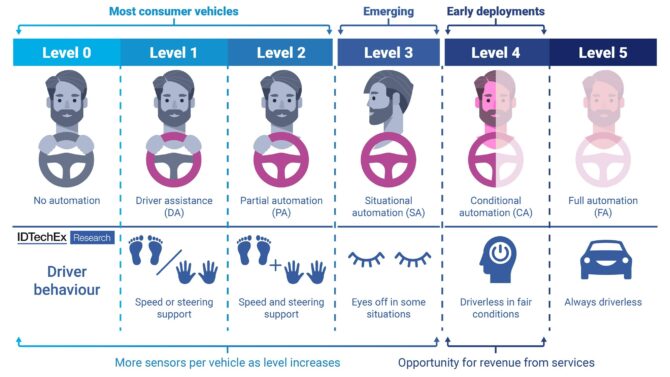Autonomous driving, electric vehicles, connected and software-defined vehicles, and in-cabin monitoring are all megatrends reshaping the automotive industry. Together, these technologies combine to form a US$1.6 trillion opportunity by 2034, nearly a 10-fold increase compared to 2023, according to a recent report from IDTechEx. Much of this potential market revenue will be coming from components required for electrification and automation, but the report predicts that services offered by autonomous and connected vehicles have the most room for growth.
Autonomous, connected and software-defined cars
Autonomous cars are still in the early days, with commercial testing starting to scale in the US and China, but recent events involving Cruise show that the industry still needs to be apprehensive. There is hope though. In December, Waymo announced it had surpassed seven million driverless miles across San Francisco, Los Angeles and Phoenix. In this time, it claims to have shown that its vehicles are 6.7 times less likely to be involved in an injury-causing accident compared to human drivers. Despite this success, any incident should and will be scrutinized, and it will take time for regulations and public trust to build. But, over a ten-year horizon, there will be significant growth of autonomous mobility-as-a-service (MaaS), with services spreading to hundreds of cities worldwide and generating hundreds of trillions of dollars in revenue.

Autonomous driving brings hardware and service revenue opportunities. Source: IDTechEx
While autonomous cars are still finding their footing, connected vehicles are already a reality in the automotive industry. Over the past few years, IDTechEx has seen OEMs bring in new revenue models based on a feature-as-a-service (FaaS) plan. This allows customers to subscribe to some features of their vehicle, like a heated steering wheel, as they need it. IDTechEx predicts that these models and the features on offer will grow more all-encompassing and complex over the next decade.
With both autonomous mobility services and connected vehicle services being in their infancy today but growing into hundred-billion-dollar industries in ten years’ time, it is no wonder the automotive industry is so excited about them. IDTechEx finds that revenue generated through future automotive technology services will grow at a CAGR of 44.4% between 2023 and 2033.
Advertisement
Components needed for future tech
The modern transition to electric powertrains has been happening since the late 00s, and while technologies like adaptive cruise control have been around longer, it’s only in the last five to 10 years that the industry has seen a new push for high levels of automation. Most new vehicles already have a small array of sensors, but new SAE level 3 and above technologies require many sensors per vehicle. In addition to external sensors for environmental sensing, there is an even newer push for internal sensors for occupant and driver monitoring. These technologies will be crucial for keeping road users safe when autonomous systems need to hand off to the driver and be sure they are alert.
